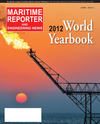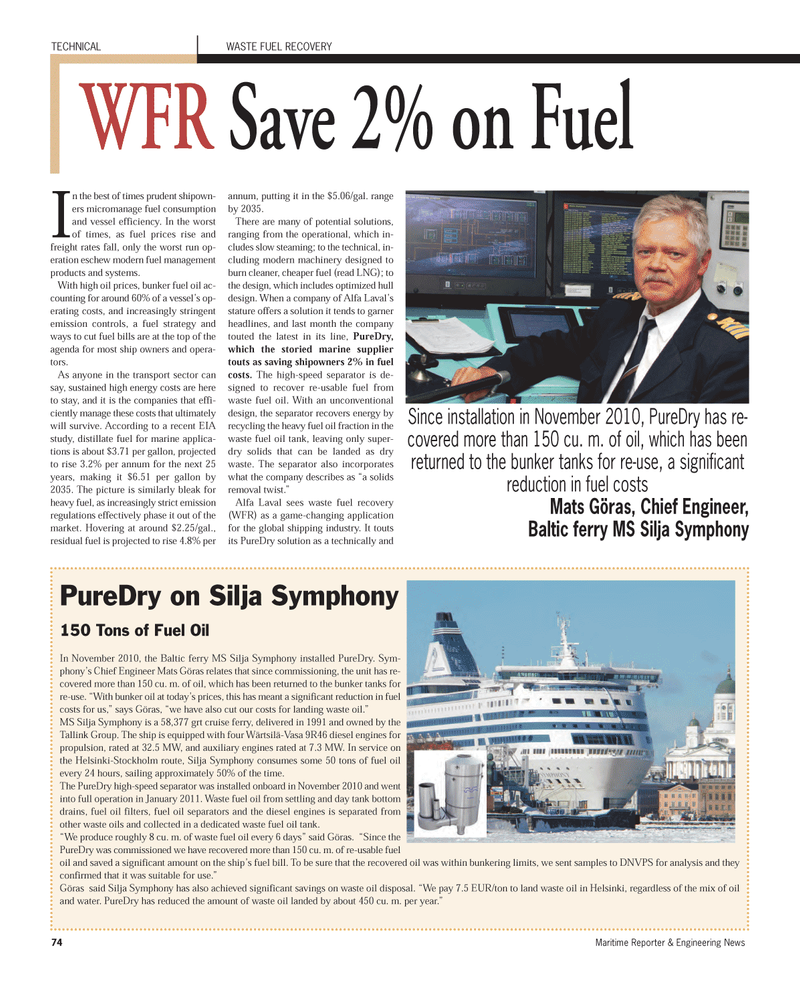
Page 74: of Maritime Reporter Magazine (June 2012)
Annual World Yearbook
Read this page in Pdf, Flash or Html5 edition of June 2012 Maritime Reporter Magazine
In the best of times prudent shipown- ers micromanage fuel consumptionand vessel efficiency. In the worst of times, as fuel prices rise andfreight rates fall, only the worst run op- eration eschew modern fuel management products and systems.With high oil prices, bunker fuel oil ac- counting for around 60% of a vessel?s op- erating costs, and increasingly stringentemission controls, a fuel strategy and ways to cut fuel bills are at the top of the agenda for most ship owners and opera- tors. As anyone in the transport sector can say, sustained high energy costs are here to stay, and it is the companies that effi- ciently manage these costs that ultimatelywill survive. According to a recent EIA study, distillate fuel for marine applica- tions is about $3.71 per gallon, projected to rise 3.2% per annum for the next 25 years, making it $6.51 per gallon by 2035. The picture is similarly bleak for heavy fuel, as increasingly strict emission regulations effectively phase it out of the market. Hovering at around $2.25/gal., residual fuel is projected to rise 4.8% perannum, putting it in the $5.06/gal. range by 2035.There are many of potential solutions, ranging from the operational, which in-cludes slow steaming; to the technical, in- cluding modern machinery designed toburn cleaner, cheaper fuel (read LNG); to the design, which includes optimized hulldesign. When a company of Alfa Laval?s stature offers a solution it tends to garner headlines, and last month the company touted the latest in its line, PureDry, which the storied marine suppliertouts as saving shipowners 2% in fuel costs. The high-speed separator is de-signed to recover re-usable fuel from waste fuel oil. With an unconventional design, the separator recovers energy by recycling the heavy fuel oil fraction in the waste fuel oil tank, leaving only super- dry solids that can be landed as drywaste. The separator also incorporates what the company describes as ?a solids removal twist.? Alfa Laval sees waste fuel recovery (WFR) as a game-changing application for the global shipping industry. It touts its PureDry solution as a technically and74Maritime Reporter & Engineering News TECHNICALWASTE FUEL RECOVERY WFRSave 2% on Fuel PureDry on Silja Symphony 150 Tons of Fuel Oil In November 2010, the Baltic ferry MS Silja Symphony installed PureDry. Sym- phony?s Chief Engineer Mats Göras relates that since commissioning, the unit has re- covered more than 150 cu. m. of oil, which has been returned to the bunker tanks for re-use. ?With bunker oil at today?s prices, this has meant a significant reduction in fuel costs for us,? says Göras, ?we have also cut our costs for landing waste oil.? MS Silja Symphony is a 58,377 grt cruise ferry, delivered in 1991 and owned by the Tallink Group. The ship is equipped with four Wärtsilä-Vasa 9R46 diesel engines for propulsion, rated at 32.5 MW, and auxiliary engines rated at 7.3 MW. In service on the Helsinki-Stockholm route, Silja Symphony consumes some 50 tons of fuel oil every 24 hours, sailing approximately 50% of the time. The PureDry high-speed separator was installed onboard in November 2010 and went into full operation in January 2011. Waste fuel oil from settling and day tank bottom drains, fuel oil filters, fuel oil separators and the diesel engines is separated from other waste oils and collected in a dedicated waste fuel oil tank. ?We produce roughly 8 cu. m. of waste fuel oil every 6 days? said Göras. ?Since the PureDry was commissioned we have recovered more than 150 cu. m. of re-usable fuel oil and saved a significant amount on the ship?s fuel bill. To be sure that the recovered oil was within bunkering limits, we sent samples to DNVPS for analysis and they confirmed that it was suitable for use.? Göras said Silja Symphony has also achieved significant savings on waste oil disposal. ?We pay 7.5 EUR/ton to land waste oil in Helsinki, regardless of the mix of oil and water. PureDry has reduced the amount of waste oil landed by about 450 cu. m. per year.? Since installation in November 2010, PureDry has re- covered more than 150 cu. m. of oil, which has been returned to the bunker tanks for re-use, a significant reduction in fuel costs Mats Göras, Chief Engineer, Baltic ferry MS Silja SymphonyMR June12 # 10 (74-80):MR Template 6/13/2012 11:45 AM Page 74

 73
73

 75
75
